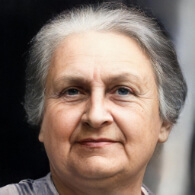Casa dei Bambini (Montessori)
The Children's House (Casa dei Bambini in Italian, often also referred to as Kinderhaus in German) is a term used in Montessori education to refer to a prepared environment for children aged three to six years.[1] This space is meticulously designed to meet all of a child's developmental needs in a safe and secure environment. The term Kinderhaus emerged during Montessori's collaborative work with Clara Grunewald in Germany before the rise of Adolf Hitler. The Association Montessori Internationale (AMI) was actually first registered in Berlin, which might explain the use of the German spelling.[2]
Montessori Quotes
- "The first idea that the child must acquire, in order to be actively disciplined, is that of the difference between good and evil; and the task of the educator lies in seeing that the child does not confound good with immobility, and evil with activity, as often happens in the case of the old-time discipline... And all this should be achieved in the way we have already indicated, by operating on the environment, not on the child."[3]
- "The child, in fact, once he feels sure of himself, will no longer seek the approval of authority after every step."[4]
Research and Critiques
- Pros: The Children's House in the Montessori method allows children to explore, learn at their own pace, and develop social skills in a carefully prepared environment. Research supports the benefits of this approach, with students showing high levels of independence and self-regulation.[5]
- Cons: Critics argue that the Montessori approach may not cater to all children, particularly those who thrive in more structured or group-based learning environments.[6]
Comparisons to Other Methods
Unlike traditional preschools, which often focus on teacher-led activities and group play, the Children's House focuses on individual exploration and hands-on learning.[7]
See Also
Glossary of Montessori Terms
The Glossary of Montessori Terms is a collection of specific terms and vocabulary that are related to the Montessori method of education, primarily focusing on the theory and practice for children aged 3 to 6. The jargon used by Montessori educators offers a unique insight into child development as discussed by Maria Montessori. The 'Montepedia Glossary of Montessori Terms' originated from a glossary that was compiled by the late Annette Haines from the Montessori Training Centre of St. Louis, at the request of Molly O'Shaughnessy from the Montessori Centre of Minnesota. The reason behind the creation of this glossary was to supplement O'Shaughnessy's lecture at the Joint Annual Refresher Course that took place in Tampa, Florida, in February 2001.[8] The glossary has since been expanded and updated with additional 'Montessori Terms'.
- 3-Hour Work Cycle
- Absorbent Mind
- Adaptation
- Adolescence
- Albums
- Advisor
- Analysis of Movement
- Casa dei Bambini
- Children of the Earth
- Children's House
- Choice
- Classification
- Concentration
- Concrete to Abstract
- Control of Error
- Coordination of Movement
- Cosmic Education
- Creativity/Imagination
- Cycle of Activity
- Development of the Will
- Deviations
- Didactic Materials
- Director
- Discipline from Within
- Earth Child
- Elementary Classroom
- Erdkinder
- Exercises of Practical Life
- False Fatigue
- Freedom of Choice
- Freedom within Limits
- Grace and Courtesy
- Great Stories
- Ground Rules
- Guide
- Help from Periphery
- Human Tendencies
- Imagination
- Independence
- Indirect Preparation
- Indirect Presentation
- Isolation of a Difficulty
- Intrinsic Motivation
- Job
- Kinderhaus
- Language Appreciation
- Language Acquisition
- Learning Explosions
- Materials
- Materialised Abstractions
- Mathematical Mind
- Maximum Effort
- Mixed Ages
- Montessori Materials
- Nido
- Montessori Materials
- Normalization
- Obedience
- Peace
- Personality
- Planes of Development
- Points of Interest
- Practical Life
- Phonemic Awareness
- Phonics Instruction
- Phonological Awareness
- Prepared Environment
- Presentation
- Primary Classroom
- Psychic Embryo
- Reading Comprehension
- Repetition
- Respect
- Self-Discipline
- Self-Regulation
- Sensitive Periods
- Sensorial Materials
- Simple to Complex
- Socialization
- Society by Cohesion
- Sound Games
- Three-Hour Work Cycle
- Valorisation
- Vocabulary Enrichment
- Work
Please help to translate this page into your local language
References
- ↑ Montessori, M. (1912). The Montessori Method. Frederick A. Stokes Company.
- ↑ Kramer, R. (1976). Maria Montessori: A Biography. Diversion Books.
- ↑ Montessori, M. (1912). The Montessori Method. Frederick A. Stokes Company.
- ↑ Montessori, M. (1912). The Montessori Method. Frederick A. Stokes Company.
- ↑ Lillard, A. (2017). Montessori: The Science Behind the Genius. Oxford University Press.
- ↑ Egan, K. (2002). Getting it wrong from the beginning: Our progressivist inheritance from Herbert Spencer, John Dewey, and Jean Piaget. Yale University Press.
- ↑ Mooney, C. (2013). Theories of Childhood, Second Edition: An Introduction to Dewey, Montessori, Erikson, Piaget & Vygotsky. Redleaf Press.
- ↑ Haines, A. (2001). Glossary of Montessori Terms. Montessori Training Centre of St. Louis.
